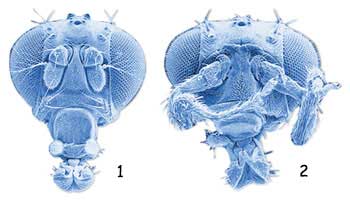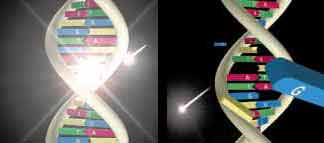Mutations
Mutations are genetic accidents that occur in living things. Like all accidents, they cause harm and destruction. "Evolution" through mutation is as unlikely as the improvement of a clock by a hammer blow.
Realizing that natural selection has no evolutionary function, evolutionists introduced the concept of "mutation" to their claim in the 20th century. Mutations are distortions taking place in the genes of organisms through external effects such as radiation. Evolutionists claim that these distortions cause organisms to evolve.
 |  |
EFFECTS OF CHERNOBYL The main cause of mutation in humans is radioactivity. The effects of mutations are always detrimental. Those who were exposed to mutation because of the disaster in Chernobyl either suffered from fatal cancers or were born with crippled organs as seen in the pictures. | MUTATION TWINS The disorder resulting in "Siamese twins" in humans is caused by mutations. These twin frogs which were conjoined at birth give us an idea of the results of mutation. |
Scientific findings, however, reject this claim, because all observable efficient mutations cause only harm to living things. All mutations that take place in humans result in mental or physical deformities such as mongolism (Down's syndrome), albinism, dwarfism, or diseases such as cancer.
 | FRUIT FLY EXPERIMENTS For decades, evolutionists carried out mutation experiments on fruit flies because they reproduce very rapidly and can be easily mutated. These creatures were mutated millions of times in all possible ways. However, not even one beneficial mutation has been observed. The head of a fruit fly before it is mutated Result of mutation: Legs jutting from the head |
Another reason why it is impossible for mutations to cause living things to evolve is that mutations do not add any new genetic information to an organism. Mutations cause existing genetic information to be randomly reshuffled similar to playing cards. In other words, no new genetic information is introduced by mutations.
 |
Evolutionary theory, however, asserts that the genetic information of living things increases over time. For instance, while a very simply structured bacterium comprises of 2,000 different types of proteins, a human's organism has 100,000 types of proteins. Exactly 98,000 new proteins have to be "discovered" for a bacterium to evolve into a human being. It is by no means possible for these protein structures to be produced by mutations, because mutations cannot add anything to a DNA chain.
Not surprisingly, so far, not even a single mutation has been observed to develop the genetic information of any life form. Despite being an evolutionist himself, the Former President of the French Academy of Sciences, Pierre-Paul Grassé, made the following admission: "No matter how numerous they may be, mutations do not produce any kind of evolution."18
 | THE DISTORTION OF DNA The code in DNA determines the physical traits of living things. If a displacement or relocation occurs in this code, because of an external effect like radiation, the organism mutates. |
Footnotes
18) Pierre-Paul Grass, Evolution of Living Organisms, Academic Press, New York, 1977, S. 88
- An Outdated View: The Theory of Evolution
- The Origin of Life
- The Design in the Protein
- The Design in the Cell
- Genetic Information
- The Design in Nature
- Miller's Experiment
- The Natural Selection Misconception
- Mutations
- Irreducible Complexity
- Impasse of Intermediate Forms
- The Cambrian Period
- Fish and Amphibians
- Coelacanth Misconception
- Reptiles
- Birds and Reptiles
- Archaeopteryx Misconception
- Bird Feathers
- The Origin of Mammals
- Living Fossils
- The Tale of Man's Evolution
- Australopithecus
- Homo Erectus
- A Lost Human Race: Neanderthals
- The Collapse of the Family Tree
- The Bipedalism Impasse
- False Faces
- Piltdown Scandal
- Why is Evolution Defended?
- The Obvious Truth: Creation
